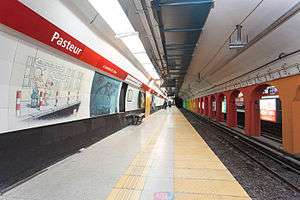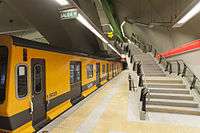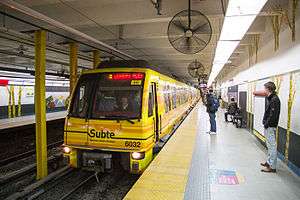Line B (Buenos Aires Underground)
_bullet.svg.png) Line B | |||
|---|---|---|---|
|
Entrance to Callao station | |||
| Overview | |||
| Type | Rapid transit | ||
| System | Buenos Aires Underground | ||
| Termini |
Leandro N. Alem Juan Manuel de Rosas | ||
| Stations | 17 | ||
| Daily ridership |
412,882 (2009)[1] | ||
| Operation | |||
| Opened | 1930 | ||
| Operator(s) | Metrovías | ||
| Character | Underground | ||
| Technical | |||
| Line length | 11.75 km (7.30 mi) | ||
| Track gauge | 1,435 mm (4 ft 8 1⁄2 in) | ||
| Electrification | Third rail and catenary | ||
| |||
Line B of the Buenos Aires Underground runs 11.75 kilometres (7.30 mi) from Leandro N. Alem to Juan Manuel de Rosas in Villa Urquiza. Line B opened to the public on 17 October 1930.[2][3]
In recent years, it has held the title of being the most used line, and increased even more so after the opening of a section of tunnel between Los Incas station in the neighborhood of Parque Chas and a shopping centre in Villa Urquiza. It was the first line in Buenos Aires whose stations had turnstiles and moving stairways.
It is the only line that uses third rail current collection, while the rest collect electric current from overhead lines, though there has been ongoing conversion to overhead lines to incorporate new rolling stock. Its gauge of 4 ft 8 1⁄2 in (1,435 mm) is the same as the rest of the Buenos Aires underground system.
The rolling stock currently used on the B line are former Tokyo Metro (formerly Eidan Subway) 300/500/900 stocks, which was used on Marunouchi Line and CAF 5000 stock. These Japanese units were acquired in the early 1990s, and offer less sitting room than the previous setup, increasing the line's capacity during peak hours. The Japanese trains are being phased out and replaced by newer CAF 5000 and CAF 6000 rolling stock acquired from the Madrid Metro.
History
In 1912 the Congress of Argentina enacted Law 8,870 to carry out the line that would unite the Correo Central (Central Post Office) and the intersection of Triumvirato and Elcano streets, splice site with the tracks of the Buenos Aires Central Railroad (Ferrocarril Central de Buenos Aires or FCCBA), which belonged to the same business group through an 8.7 km tunnel. The Act provided that the works "would clear in part the traffic in the central area of the city".
Latterly on 17 December 1927 in New York City the financial agreement to build was signed between Teófilo Lacroze, the president of Banco de la Nación Dr. Tomás de Estrada, Dr. Louis J. Rocca directory owner of Ferrocarril Terminal de Buenos Aires and bankers Harris and Forbes. This will grant the concession of the line for passengers, parcels and freight to Lacroze Brothers Company.


The construction was done by the Argentine builder Dwight P. Robinson & Cía, and the line was called Ferrocarril Terminal Central de Buenos Aires (Buenos Aires Central Terminal Railroad). The first section between Federico Lacroze and Callao opened on 17 October 1930 and measured 7.021 km. The maiden voyage was made by President de facto José Félix Uriburu.
On 22 June 1931, it was extended to Carlos Pellegrini station. Finally, the line was completed on 1 December 1931 when the subway reached the station Leandro N. Alem. These three sections were carried out entirely below Corrientes Avenue, including 19 curves and 13 stations.
According to the depth of the line, some sections were made by open ditch (cut-and-cover method) or gallery or tunnel. As so were performed mainly at open skies the stations Federico Lacroze, Dorrego, Canning, (now Malabia), Río de Janeiro, (now Ángel Gallardo) and Medrano . When you reach the tunnel at Maipu Street the maximum depth reached 17 metres. Underneath the Rancagua (today Los Andes) park, in Chacarita, a workshop and a 10 track garage (with capacity for 110 wagons) were built.
This line had escalators and turnstiles for the payment of coin-operated service, initially manufactured in United States, formerly controlled by guards. It also was deeper than the Line A, and like it, each station was decorated with friezes of characteristic colors.
An underground link with the subsoil of the Mercado Central de Abasto (central wholesale fruit and vegetable market) was made available on 12 July 1933, by which goods wagons with freight from the Ferrocarril Central de Buenos Aires (Buenos Aires Central Railroad) would arrive, driven by electric locomotives. This was lifted after the fire occurred on 27 November 1952. From the beginning the circulation was protected by an automatic luminous signalization, with devices for mechanic trains, which were substituted in 1980 for others of magnetic induction, also replaced in 1998 for an electric system with ATP.
Recent expansion and refurbishment

Line B was recently extended underground further west (2 km) from Los Incas/Parque Chas to Echeverría and Juan Manuel de Rosas (previously named Villa Urquiza) where transfer to the Ferrocarril Mitre is provided. The new stations opened in July 26, 2013.[4]
Further plans include: installation of a new signal system, acquisition of new cars, construction of a new central workshop for the repair of machinery, widening of platforms, hallways and all areas of pedestrian traffic at stations and at transfer nodes, improvements in transfer centers with other means of transport[5]
Some refurbishment on the line has come under criticism, mostly due to the overwhelming colour of the new murals, but also due to alleged cases where the historic artwork of the line has been destroyed during the line's modernisation.[6][7]
Rolling stock


Line B inaugurated with 56 English Metropolitan Cammell cars (numbered from 101 to 156), of two bogies and metallic bodywork painted with cream and red colours on the exterior, with decorative artwork and dark blue coloured doors. Each car had two 105 HP motors. The interiors had 47 wooden seats, the majority with reversible back and three slide doors on each side, at the platforms level, of opening and closure commanded by the guard. One year later, 20 similar cars made by Osgood Bradley Car Company of the US were incorporated.[8]
The Japanese-built Eidan 300/400/500/900 sets, which ran on line B starting in 1996, were in service on the Marunouchi Line in Tokyo from 1959 through late 1995. In 2009, it was announced that the Madrid Metro has sold its oldest wide-profile trains to Buenos Aires. The 5000 series trains, which were in operation in Madrid since 1974, entered service in 2011 to replace some of the Eidan 300/400/500/900 sets that were utilized on line B starting in 1996.
In July 2013, Madrid Metro sold 73 of its 6000 series cars (which entered service in Madrid in 1998) to Buenos Aires for €32.6 million in exchange for the retirement of the rest of the Japanese-built trains.[9][10][11][12][13][14][15] The purchase of the CAF 6000 rolling stock has been met with criticism due to major alterations that were made to the line to accommodate the cars' height, as well as the fact that the second-hand units were not significantly cheaper than simply purchasing new rolling stock, as was done with Line A.[16][17]
Events and highlights
- When excavation was carried out for construction of the Leandro Alem station, the remains of a Mammoth of the Quaternary period where found, which were sent to the Museum of Natural Sciences of La Plata.
- Line B connects –through a ramp at Federico Lacroze– non-revenue service into the electrified track of Urquiza Line, where the underground rolling stock heads to the Urquiza Railway workshops in Ruben Darío (Hurlingham) for wheel, gear and axle maintenance.
- Until the privatization of subte in the 1990s, the B line was identified by the green color, whilst the D line used red.
- Florida and Carlos Pellegrini stations are the two busiest stations on the line, as most commuters alight there in the morning to work in the downtown financial district. They also provide easy access to the entertainment district in the evening (see also Florida Street).
- Carlos Pellegrini station can be reached from an underground commercial gallery located right below the Obelisco landmark, used by pedestrians to avoid crossing 9 de Julio Avenue at street level.
- Since the 1940s, the line used to end in Federico Lacroze Station, near Chacarita Cemetery, where commuters could board the suburban bound Urquiza Line. In the 1990s, work began to expand the line to Villa Ortúzar and Villa Urquiza.
Gallery
.jpg) Uruguay station hall (1931)
Uruguay station hall (1931).jpg) Carlos Pellegrini station (1931)
Carlos Pellegrini station (1931) Los Incas station
Los Incas station- Exit from the Obelisco commercial gallery
- Eidan 500, formerly used on Tokyo Metro Marunouchi Line
References
- ↑ Subte récord: ya transporta 1.7 millón de pasajeros por día. Clarín - (Spanish) - Retrieved 2011-01-20
- ↑ La linea B del subte cumple 78 años- su historia (Spanish) Retrieved 2008-11-04
- ↑ Subterráneos de Buenos Aires– Nuestra Historia (Spanish)
- ↑ Echeverría y Rosas, inauguradas (Spanish)
- ↑ Subte: hay récord histórico de pasajeros y falta inversión (Spanish)
- ↑ El patrimonio de la línea B, en su peor momento - EnElSubte, 27 April 2015.
- ↑ SBASE ahora afirma que las pinturas sobre revestimiento falso son “lavables y de larga duración” - EnElSubte, 11 February 2015.
- ↑ Subterráneos de Buenos Aires History of Line B – Retrieved 2010-11-04
- ↑ http://www.enelsubte.com/noticias/sbase-compra-metro-madrid-73-coches-caf-serie-6000-la-linea-b-2750
- ↑ http://www.enelsubte.com/noticias/metro-madrid-despacha-los-primeros-caf-6000-3037
- ↑ http://www.enelsubte.com/noticias/planean-renovacion-masiva-flota-la-linea-b-2622
- ↑ http://www.enelsubte.com/noticias/trenes-mitsubishi-convivirian-los-caf-5000-y-6000-la-linea-b-3036
- ↑ http://parabuenosaires.com/subtes-ciudad-compra-mas-de-70-vagones-serie-6000-a-madrid/
- ↑ http://www.ferronoticias.net/2014/01/28/serie-6000-metro-de-madrid-argentina/
- ↑ http://www.metromadrid.es/es/comunicacion/prensa/2014/Enero/noticia07.html
- ↑ La peor compra de material rodante de la historia del Subte - EnElSubte, 6 March 2015
- ↑ Piden informes al GCBA por los trenes usados para la línea B - EnElSubte, 15 March 2015
External links
| Wikimedia Commons has media related to Line B. |
- Subterráneos de Buenos Aires (Official Page)
- Metrovías S.A. Subte Operator (Official Page)
- Subterráneos de Buenos Aires, B Line
- System map
- La ruina de la línea B (Spanish)
